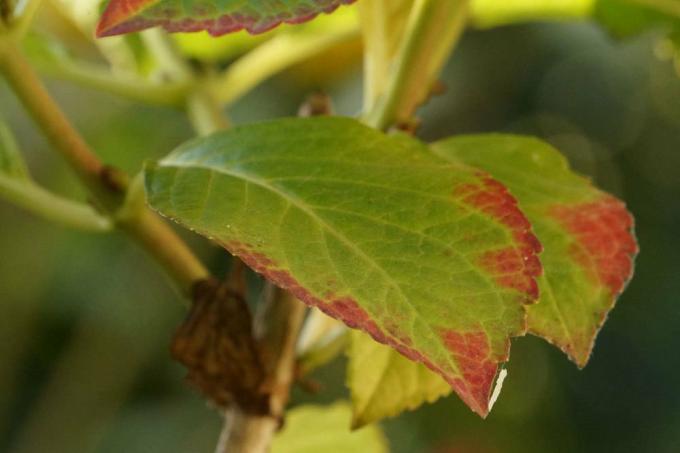
table of contents
- Burnt hydrangea: relocation
- Sun protection
- Let the leaves stand
If you burn the leaves of your hydrangeas, action must be taken. As soon as the foliage of the popular ornamental shrubs has light or brown spots that begin at the tip of the leaf, the hydrangea family will suffer from sunburn.
Burnt hydrangea: relocation
The cause of a burnt hydrangea is always the location. Hydrangea prefer a partially shaded to shady spot in the garden, as they are originally forest plants that mainly grow at the foot of dense shrubs or tall trees. As soon as you realize that the hydrangea leaves are burning, your specimens are in a spot that is too sunny, which you should change as soon as possible.

Rule of thumb: To avoid heat damage, hydrangeas should be in the shade from 11 a.m. The wood naturally tolerates the evening sun better again.
The location should therefore not only be dark enough:
- no south exposure
- East or west facing recommended
- no direct sunlight
As the leaves recover over time, you need to pay more attention to the hydrangea shoots. When the foliage burns, young shoots can dry up and must be removed. It also becomes problematic when it comes to older, planted specimens. Hydrangeas are quite true to their location and are difficult to plant in another place. For this reason, you need to choose a suitable location before actually planting. If you want to plant a potted hydrangea that has been kept indoors, it must first be accustomed to the new conditions. To do this, place the plant outdoors more and more often, preferably in the morning and evening. The midday sun is simply too intense for the sensitive houseplants.
Tip: Never water hydrangeas over midday or directly over the foliage. The water droplets act like a magnifying glass and increase the chances of burns, especially over the summer.
Sun protection
If it is not possible to relocate, you can equip your hydrangea with sun protection if the leaves are burnt. A shade provider is ideal if the plants are in a place that is exposed to the direct midday sun or is permanently lit. Suitable for this purpose are:
- Umbrellas
- Shading nets
- Climbing plants on the trellis

If you have any other idea than sun protection, you can use that too, as long as you give the hydrangea enough air and space. You can easily move pail specimens over midday if they would get too much sun. Shade is especially important on hot summer days.
Let the leaves stand
One of the most important points after a hydrangea sunburn is the leaves. Ideally, these should not be removed, even if most of the plant is stained. The reason for this are the flowers. Hydrangea flowers are supported in their growth by the foliage and are therefore dependent on them. Fortunately, since it is not a disease or a pest infestation, but only a care mistake, the green does not have to be removed. If the location is optimized, the hydrangea leaves will recover over time and new ones will be formed. The attractive flowers will do better as a result.
Note: If you want to cut the foliage, you can do so if you don't cut too deep or too much. To do this, place the cut under the next pair of leaves so that the plant can sprout quickly and recover.
